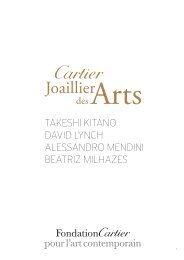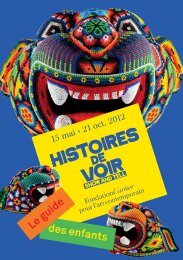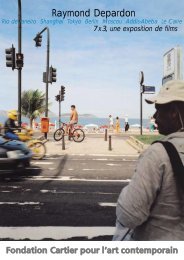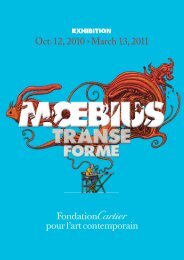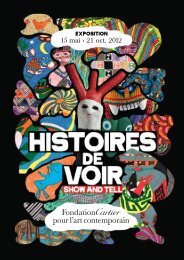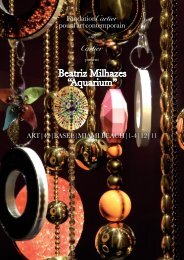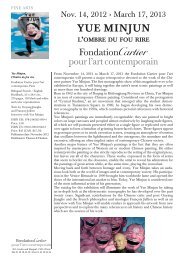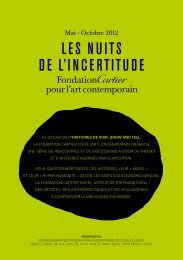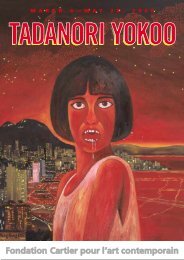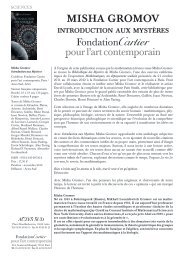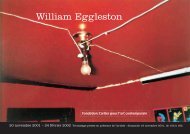Download - Fondation Cartier pour l'art contemporain - Cartier
Download - Fondation Cartier pour l'art contemporain - Cartier
Download - Fondation Cartier pour l'art contemporain - Cartier
Create successful ePaper yourself
Turn your PDF publications into a flip-book with our unique Google optimized e-Paper software.
RON MUECK<br />
NOVEMBER 19, 2005—FEBRUARY 19, 2006<br />
RON MUECK’S BODIES AND SOULS by Robert Rosenblum<br />
[…] Dead Dad, one of Mueck’s earliest works, immediately established his singularity,<br />
not only in its fanatical insistence on the perfect replication of every hair, pore, wrinkle, or muscle that defines<br />
an individual face and body, but in its shrinking of natural human dimensions to an alarmingly unnatural size.<br />
This unique vision is no less indelibly printed on every sculpture he has made, so much so, in fact, that we tend<br />
to think of him as a modern Frankenstein, the creator of a private universe of humanoids that both mirror us<br />
and transform us into alien creatures. But like the inventions of even the strangest and most individual artists—<br />
William Blake, for example—Mueck’s creatures can also be seen as branches off many different historical trees,<br />
both past and present. As for the present, his work, in fact, can easily be seen as belonging to a growing<br />
progeny of synthetic human beings spawned by artists who seem to be responding to a contemporary world<br />
in which perfect replications—whether electronic or biological, a computer print-out or a cloned lamb—are<br />
saturating our experience and blurring distinctions between originals and copies, between the natural and the<br />
artificial. […] Mueck’s work fits comfortably into this expanding population of artists who have turned from<br />
the artificial language of abstraction to the no less artificial language of realism, artists who, like the old<br />
masters, can create such personal variations on three-dimensional facsimiles of the human body that we can<br />
recognize immediately their individual hands. […]<br />
[…] But Mueck’s choice of themes is no less distinctive, since he dares to tackle the kind<br />
of subjects avoided by most contemporary artists, namely, the timeless, universal cycles of human existence,<br />
from the womb to the tomb. The depiction of these momentous events in the stages of life, love, and death<br />
was fundamental to Western art, recreated through biblical narratives and classical mythology; but for Mueck,<br />
these pivotal experiences are recreated through the private lives of individuals, naked or clothed, whom we<br />
recognize as members of our own world. […]<br />
In describing the often painful realities of these works, what has not been mentioned so<br />
far is their equally strong component of fantasy, instantly triggered by Mueck’s refusal to render his sculptures<br />
as life-size figures. Instead, he startles us further by making them either smaller or larger than life, sometimes<br />
with relatively subtle deviations from normal human dimensions, but more often with extreme exaggerations<br />
of size that turn his figures into eerie races of pygmies and giants. In terms of the traditional history of<br />
sculpture, there is nothing unusual about this. Michelangelo’s David is heroically scaled at a height of more<br />
than four meters (13 l/2 feet), that is, twice normal size; whereas a table sculpture by Clodion of frolicking<br />
nymphs and satyrs might be held in one hand. Figural sculpture, in fact, has always come in many sizes. But<br />
when the figures become such frighteningly real facsimiles of ourselves and our contemporaries, these<br />
shrinking and expanding dimensions transport us immediately to another territory, one closer to a world of the<br />
irrational, where fearful creatures can shrivel into nothingness or loom high on the horizon. […]<br />
Although at the Royal Academy’s Sensation show Mueck first became known within a<br />
context of rebellious young British contemporaries, including Jenny Saville, who presumably turned their backs<br />
on the past, it quickly became clear that his work was deeply rooted in the most venerable traditions of<br />
Western art. Confronted with his passion for verisimilitude in sculpture, critics would often write about his<br />
work by invoking ancestors, which might range all the way from the legend of Pygmalion and Galatea or the<br />
palpable realities of Spanish Baroque polychrome sculpture (where real hair, blood stains, and glass tears<br />
4



